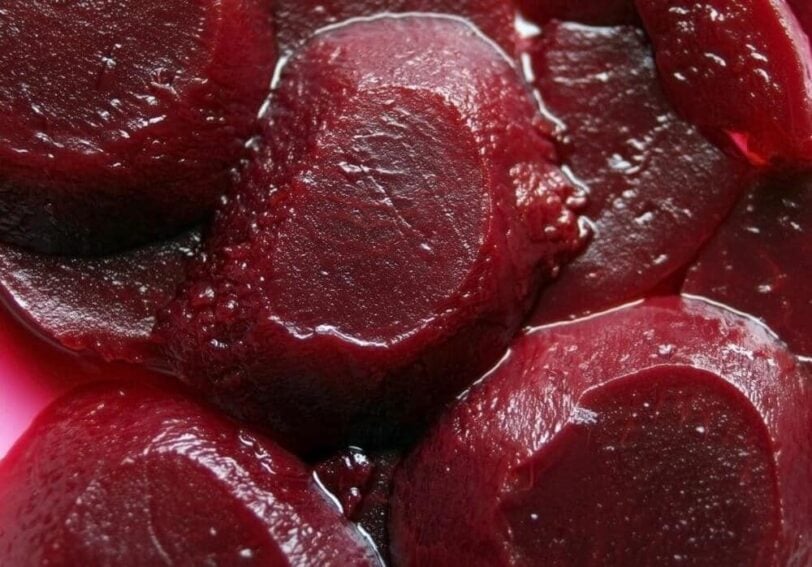Pickled beets are a traditional fermented, probiotic food that improves digestion by stimulating stomach acid and bile, and supports your immune system by replenishing the beneficial bacteria in your gut.
They are easy to make and hard to keep around!
Beet Nutrition
Although typically a beautiful reddish-purple hue, beets also come in varieties that feature white or golden roots, as well as rings and stripes.
These colorful root vegetables contain powerful nutrient compounds that help protect against heart disease, birth defects and certain cancers, especially colon cancer. Beets are an excellent source of the B vitamin, folate, and a very good source of manganese and potassium. They are a good source of dietary fiber, vitamin C, magnesium, iron, copper and phosphorus.
The main ingredient in the traditional eastern European soup, borscht, beets are delicious eaten raw, but are more typically cooked or pickled. Raw beet roots have a crunchy texture that turns soft and buttery when they are cooked.
Beet leaves are delicious and can be prepared raw or cooked as you would use spinach or Swiss chard. They are incredibly rich in nutrients, concentrated in vitamins and minerals as well as carotenoids such as beta-carotene and lutein/zeaxanthin.
And when beets are fermented (see recipe below), they become little powerhouses of nutrition!
More About Beets
Beet Selection and Storage
Choose small or medium-sized beets whose roots are firm, smooth-skinned and deep in color. Smaller, younger beets may be so tender that peeling won’t be needed after they are cooked.
Avoid beets that have spots, bruises or soft, wet areas, all of which indicate spoilage. Shriveled or flabby should also be avoided as these are signs that the roots are aged, tough and fibrous. While the quality of the greens does not reflect that of the roots, if you are going to eat them, look for greens that appear fresh, tender, and have a bright green color.
Store beets unwashed in the refrigerator crisper where they will keep for two to four weeks. Cut the majority of the greens and their stems from the roots, so they do not pull away moisture away from the root. Leave about two inches of the stem attached to prevent the roots from “bleeding.”
Store the unwashed greens in a separate plastic bag where they will keep fresh for about four days.
More Pickle Recipes
- Garlic Pickled Greens
- Watermelon Rind Pickles
- Heirloom Tomato Pickles
- Simple Homemade Sauerkraut
- Small Footprint Dill Pickles

Simple Pickled Beets
Ingredients
- 5 pounds beets, peeled (red, golden or striped. Don’t use golden or striped beets with red ones unless you don’t mind if all the beets to turn red)
- 2 Tbsp. sea salt
- 1 Tbsp. caraway seeds
Instructions
- Thoroughly clean and sterilize the container and utensils you will be using.
- Wash, drain and then cut your beets into disks, halves or quarters. Optionally, you can grate, slice, shred or chop the beets into a non-metal bowl. You can do this by hand or with a food processor. Pieces should be about the size of a quarter, or smaller. (I prefer a coarse shred.)
- With a wooden spoon, mix the grated beets with sea salt, to taste.
- Add caraway seeds either whole or crushed. Crushed caraway seeds give a more intense flavor.
- Pack the beets firmly and evenly into a clean crock, glass jar or enamel container until liquid comes out of the beets freely. Leave 2 inches of room at the top of a jar or 4-5 inches of room at the top of a crock. Make sure juice covers the beets completely!
- Once beets are immersed, place fermentation weights into the jar or crock. If you don’t have weights, put a plate on top of the beets (if using a crock) and a large freezer bag filled with water on top of the plate. (I use 2 large bags, one inside the other so that if the bag breaks, it will not water down the beets into a tasteless mess.)
- Put jar or crock in a cool area where the temperature will be around 75 degrees. Fermentation will begin within a day, depending upon the room temperature. If temperature too high or too low, the beets may not ferment and could spoil!
- Cover the container with a clean towel and check after 2 days, releasing some of the carbon dioxide that has built up inside. Scoop any scum off the top (it is harmless), and repack. Check every 3 days and repeat as necessary.
- After 2 weeks, sample the beets to see if they taste ready to eat. The flavor will continue to mature for the next several weeks. Refrigerating the beets will extend their shelf life.













35 thoughts on “Simple Pickled Beets (Gluten Free, Paleo, Vegan)”